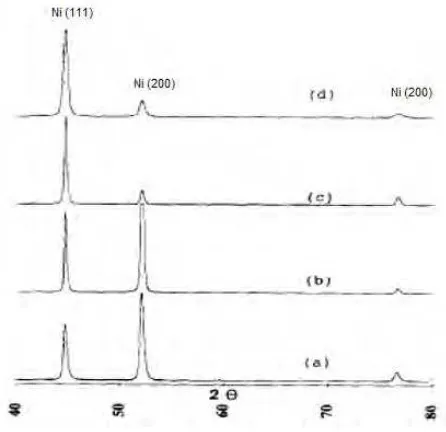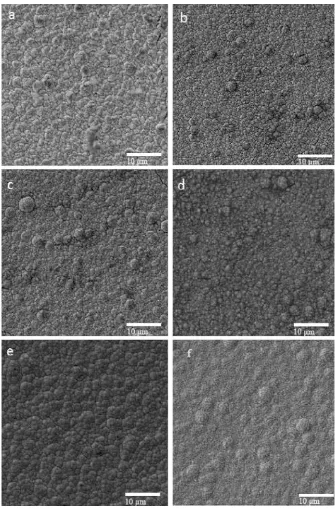UNIVERSITI TEKNIKAL MALAYSIA MELAKA (UTeM)
WEAR BEHAVIOR AND CORROSION RESISTANCE OF NICKEL
COATINGS ELECTRODEPOSITED ON ALUMINUM ALLOY 7075
SUBSTRATE VIA VARIOUS CURRENT DENSITY
Report is submitted in accordance with requirement of the Universiti Teknikal Malaysia Melaka (UTeM) for the Bachelor Degree of Manufacturing Engineering (Engineering
Materials) (Hons.)
by
SAIFUL AZHAN BIN MD ZAHIR B051110070
910614-02-5353
FACULTY OF MANUFACTURING ENGINEERING
UNIVERSITI TEKNIKAL MALAYSIA MELAKA
BORANG PENGESAHAN STATUS LAPORAN PROJEK SARJANA MUDA
TAJUK: Wear Behavior And Corrosion Resistance of Nickel Coatings
Electrodeposited on Aluminum Alloy 7075 Substrate Via Various Current Density
SESI PENGAJIAN: 2014/15 Semester 2
Saya SAIFUL AZHAN BIN MD ZAHIR
mengaku membenarkan Laporan PSM ini disimpan di Perpustakaan Universiti Teknikal Malaysia Melaka (UTeM) dengan syarat-syarat kegunaan seperti berikut:
1. Laporan PSM adalah hak milik Universiti Teknikal Malaysia Melaka dan penulis. 2. Perpustakaan Universiti Teknikal Malaysia Melaka dibenarkan membuat salinan
untuk tujuan pengajian sahaja dengan izin penulis.
3. Perpustakaan dibenarkan membuat salinan laporan PSM ini sebagai bahan pertukaran antara institusi pengajian tinggi. atau kepentingan Malaysia sebagaimana yang termaktub dalam AKTA RAHSIA RASMI 1972)
(Mengandungi maklumat TERHAD yang telah ditentukan oleh organisasi/badan di mana penyelidikan dijalankan)
Alamat Tetap:
No 8 Kg Petani Mukim Guar Kepayang
DECLARATION
I hereby declare this report entitled WEAR BEHAVIOR AND CORROSION RESISTANCE OF NICKEL COATINGS ELECTRODEPOSITED ON ALUMINUM ALLOY 7075 SUBSTRATE VIA VARIOUS CURRENT DENSITY is the result of my own research except as cited in the references.
Signature : ……….
Author’s Name : SAIFUL AZHAN BIN MD ZAHIR
APPROVAL
This report is submitted to the Faculty of Manufacturing Engineering of UTeM as a partial fulfillment of the requirement for the degree of Bachelor of Manufacturing Engineering (Engineering Materials) (Hons.). The member of the supervisory is as follow:
………..
(Official Stamp of Principal Supervisor)
………..
ABSTRAK
ABSTRACT
DEDICATION
ACKNOWLEDGEMENT
Alhamdulillah, first of all, I would like to extend my gratitude to Allah S.W.T for blessing me with health, love, opportunity and mercy to complete this research.
Besides that, I would like to extend my sincere gratitude to my supervisor, Dr. Intan Sharhida Binti Othman who had given me guidance and support during the whole research period. My sincere thanks also goes to Dr. Muhammad Zaimi Bin Zainal Abidin as my co-suppervisor for his invaluable opinions during the research. Not to be forgotten, I would like to thanks to other lecturers, laboratories staffs, friends and inviduals who, directly or indirectly, give contribution towards my research progress.
Last but not least, I would like to thanks to my parents who always stand by my side to give moral support and never forget to pray for me. Further, I want to acknowledge UTeM especially Faculty of Manufacturing Engineering for giving me opportunity to gain experience and knowledge during this four year of my study.
TABLE OF CONTENT
LIST OF ABBREVIATIONS AND NOMENCLATURE xi
CHAPTER 1: INTRODUCTION
2.1.3.1 Nickel Solution 6
2.3.2 Factor That Influence the Wear Behavior of Coating 15
2.3.2.1 Effect of Current Density 15
2.4 Corrosion of the Coating 17
2.4.1 Introduction 17
2.4.2 Factor That Influence the Corrosion Behavior 17
2.4.2.1 Effect of Current Density 17
CHAPTER 3: METHODOLOGY
3.1 Introduction 19
3.2 Sample Preparation 21
3.3 Acetone Clean 21
3.4 Hydrochloric Acid Etching 22
3.5 Electrodeposition Process of Nickel Coatings 23
3.5.2 Current Density 24
3.5.3 Procedure 25
3.6 Testing & Characteristic Technique 27
3.6.1 Surface Morphology 27
3.6.1.1 X-Ray Fluorescence (XRF) 27
3.6.1.2 Scanning Electron Microscopy (SEM) 28
3.6.2 Corrosion Test 30
3.6.3 Wear Test 31
CHAPTER 4: RESULT AND DISCUSSION
4.1 Introduction 32
4.2 Nickel Coating Samples Characterization 32
4.2.1 X-Ray Fluorescence (XRF) 32
4.2.2 Scanning Electron Microscopy (SEM) 33
4.3 Nickel Coating Samples Testing 38
LIST OF TABLE
2.1 Chemical composition of AA7075 12
2.2 Mechanical properties of AA7075 12
2.3 Type of AA7075 with mechanical properties. 14
3.1 Nickel Watts’s bath solution 24
3.2 Data for current used in electrodeposition process 25
3.3 Parameter used in electrodeposition process. 26
4.1 Results of corrosion test 39
LIST OF FIGURE
2.1 Electrolytic cell for the deposition of nickel from nickel sulphate 5
solution.
2.2 XRD patterns of nickel deposits from Watts plating solutions with 7
pH values of (a) 3.8; (b) 5.0; (c) 5.5; and (d) 6.0, each at 30 min
plating time
2.3 SEM micrographs of Ni–Co–W coatings produced at (a) 2.5mA/cm2, 9
(b) 5 mA/cm2, (c) 7.5 mA/cm2, (d) 15 mA/cm2, (e) 50 mA/cm2
and (f) 70 mA/cm2
2.4 Variation of grain size of Ni deposits as a function of current density 10
2.5 SEM images nickel coatings (a, d) 90 µm grain size (b, e) 62 nm 16
grain size (c, f) 13nm grain size
2.6 Polarizing curves obtained for the alloy coatings in a 3% NaCl 18
solution; (a) NC Zn–17Ni alloy, (b) NC Zn–12Ni alloy, (c) NC
Zn–14Ni alloy, (d) NC Zn–13Ni alloy, and (e) microcrystalline
3.1 Research methodology flowchart 20
3.2 Samples of AA7075 21
3.3 Process of hydrochloric acid etching 23
3.4 Electrodeposition process for nickel coating 26
3.5 X-ray fluorescence machine used for composition analysis 28
(KKTM Masjid Tanah)
3.6 Scanning electron microscopy provided in the lab 29
3.7 Three electrode system glass cell used for corrosion test 30
3.8 Ball-on-disk wear test. 31
4.1 Comparison the presence of nickel before and after coating 33
4.2 SEM image of nickel coating electrodeposited on AA7075 34
substrate with various current density: (a) 2.5 mA/cm2,
(b) 5.0 mA/cm2, (c) 7.5 mA/cm2
4.3 SEM image cross-sectional view of Ni coating electrodeposited 36
on AA7075 substrate with various current density:
(a) 2.5 mA/cm2, (b) 5.0 mA/cm2, (c) 7.5 mA/cm2
4.4 Comparison of coating thickness based on different current 37
density: (a) 2.5 mA/cm2, (b) 5.0 mA/cm2, (c) 7.5 mA/cm2
4.5 Corrosion test result for bare AA7075, coatings with 2.5 mA/cm2, 38
5.0mA/cm2, and 7.5mA/cm2 respectively.
4.6 Comparison of coefficient of friction between different current 41
LIST OF ABBREVIATIONS AND NOMENCLATURE
AA7075 - Aluminum Alloy 7075
PVD - Physical Vapor Deposition
CVD - Chemical Vapor Deposition
HVOF - High-Velocity Oxygen Fuel
NaCl - Sodium Chloride
HCl - Hydrochloric Acid
XRF - X-Ray Fluorescence
XRD - X-Ray Diffraction
SEM - Scanning Electron Microscopy
Icorr - Corrosion current
CHAPTER 1
INTRODUCTION
1.1Background of Project
Aluminum alloy 7075 (AA7075) is commonly used as a structural material in aircraft application due to their attractive properties that have high strength to weight ratio. AA7075 have chemical composition roughly of zinc (Zn) 5.1-6.1 wt. %, magnesium (Mg) 2.1-2.9 wt. %, copper (Cu) 1.2-2.0 wt. %, and chromium (Cr) 0.18-0.28 wt. %. However, this material has a problem where it has low corrosion resistance. Therefore, to overcome this problem, a coating system has been introduced to the AA7075 in order to prevent corrosion.
Further, nickel has been chosen as coating material in order to improve the corrosion resistance of AA7075. Moreover, nickel not only have good corrosion resistance but also high melting point, strength, and ductility.
This research aims to improve the corrosion resistance of AA7075 as well as the wear behaviors of the nickel coatings electrodeposited on AA7075 substrate. In order to get a good result for wear behavior, the grain size of nickel coating needs to be refined by increase the current density. Current density plays an important role on the modification of the grain size of electrodeposited coating. The grain size of the coating can be refined by applying a high current density during the electrodeposition process. The decreasing of the grain size of the coatings occur rapidly by increasing the current density (Rashidi and Amadeh, 2008).
The samples will be tested in several ways in order to determine the wear and corrosion behavior. Ball-on-disc wear tester will be used to determine the wear behavior. The corrosion test will be carried out by immersing the coating in a 3.5 wt. % of NaCl solution at room temperature.
1.2Problem Statement
AA7075 is a type of material that can easily undergo corrosion process. Thus, this alloy needs to be coated with a coating system in order to prevent the corrosion. Previously in aircraft industry, cadmium (Cd) or chromium (Cr) were widely used as a coating material. However, these coatings materials are hazardous and contain a carcinogenic element which can cause cancer.
One of the way to achieve a better wear resistance, and good corrosion resistance is by decreasing the grain size of nickel coatings. Therefore, this research is focused on increasing the surface properties of coatings by refining the grain size. According to El-Sherik and Erb (1997), the wear properties of nickel coating are influenced by the grain size of the coating. The challenge in this study is to produce coatings which can overcome the low wear and corrosion resistance of AA7075. In this research, the effect of the various current density applied in the electrodeposition process to the grain size of nickel coating will be studied.
1.3 Objectives
1. To produce nickel coatings electrodeposited on AA7075 substrate using various current density.
2. To analyse the corrosion resistance of nickel coatings electrodeposited on AA7075 substrate.
3. To determine the wear behavior of nickel coatings electrodeposited on AA7075 substrate.
1.4 Scope of Project
CHAPTER 2
LITERATURE REVIEW
2.1 Electrodeposition of Nickel
2.1.1 Introduction
2.1.2 Method of Electrodeposition
This process used a power supply to supplies a direct current that flow between two electrodes which are anode and cathode that immersed in conductive solution. The flow of direct current causes the anode electrodes to dissolve and the cathode electrode to become cover with nickel. In nickel solution contains positively charged nickel ions (cations) and negatively charged sulphate ions (anions). When current flows, the cations migrate to the cathode where they are discharged and deposited as metallic nickel, (Schlesinger and Paunovic, 2010).
2.1.3 Factor Influencing the Properties of Electrodeposited Material
2.1.3.1 Nickel Solution
Professor Oliver P. Watts in the one that formulated an electrolyte in 1916 that combined nickel sulfate, nickel chloride, along with boric acid and optimized the composition of nickel electroplating solution, (Schlesinger and Paunovic, 2010). Nowadays, this Watts solution is widely used and caused the development of modern nickel electrodeposition technology.
Nickel sulphate plays an importance role in the Watts bath solution. This salt has least expensive salt of nickel with a stable anion that is not reduced at cathode, oxidized at the anode, or volatilized. The used of nickel sulphate now is not only to raises the limiting cathode current density but also decreases the resistivity, thus improving plate distribution.
On the other hand, the chloride ion is used to improve anode dissolution by reducing polarization and also increases the conductivity of the bath. It also raises the throwing power as a result of increasing cathode efficiency, electrolyte conductivity, and slope of the cathode potential curve.
For boric acid, it serves as a weak buffer in a nickel solution that controlling the pH in the cathode. Boric acid also is helpful in its smoothing action on the deposit, and very pure with inexpensive form.
2.1.3.2 pH Solution
Range of pH in nickel solution usually can vary from 3 to 6. Keeping the pH out of this range might has some unwanted sequences. By increasing the pH solution, the deposition rate of alloy and nickel increased. While, when decreasing in pH, the deposition rate will decreased.
Figure below show the XRD patterns of the Watts Ni deposited using the plating solution at various of pH 3.8, 5.0, 5.5, and 6.0 for 30 minutes of plating time. Based on the result obtained, the preferred orientation of the deposits obtained in the nickel solution with pH less than or equal 5 is Ni (200), while Ni (111) is preferred orientation of the Watts nickel deposits when the plating solution pH is above 5 (Hu, Lin and Wen., 1996).
2.1.3.3 Temperature
2.1.3.4 Effect of Current Density on the Grain Size of Nickel Coating
Figure 2.3: SEM micrographs of Ni–Co–W coatings produced at (a) 2.5mA/cm2, (b) 5 mA/cm2, (c) 7.5


